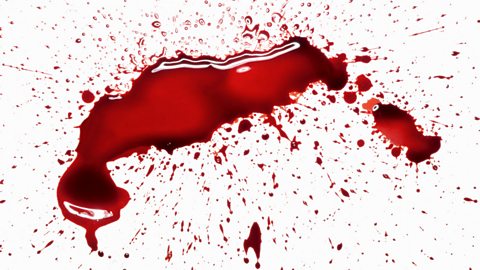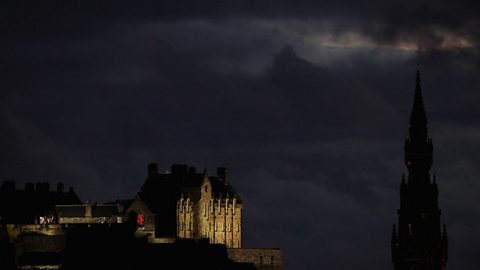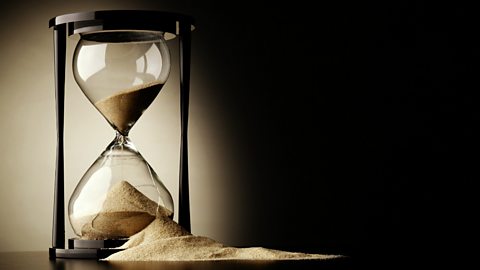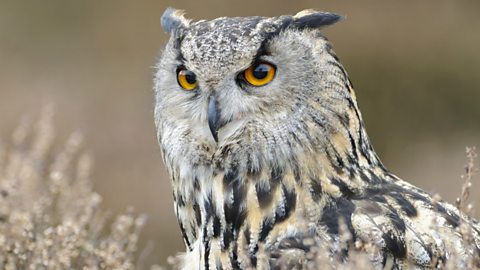Use of language in Macbeth
Language refers to the choices of style and vocabulary made by the author. When analysing the language Shakespeare uses you should think about:
- What? - the playwright's choice of specific words and literary deviceAny method an author uses to add meaning or interest to a text, such as metaphors, similes or alliteration.
- Where/how? - the way in which the writer uses them
- Why? – the effect on the reader
Social and historical context

Shakespeare was a genius with words. It is estimated that he had a vocabulary of 17,000 words (four times that of the average educated person of the time). Of these it has been calculated that he brought over 1,700 new words to the English language as well as inventing many of the phrases and sayings which we still use today. For instance, 'be all and end all', 'at one fell swoop' and 'crack of doom' all first appeared in Macbeth.
Evidence and explanation of the language used
Here are some examples of language choices which Shakespeare makes: key words and literary devices such as animal imageryThe use of language to create images and pictures in the reader's mind..
1. Key words
There are a number of key words in Macbeth which are used over and over again. This repetition reinforces their importance in the mind of the audience or reader and adds strongly to the overall atmosphere of the play. Three of the most important key words in the play are blood, night and time.
Blood
What relevance does the word 'blood' have in the play?

Blood appears as a real substance all through the play. In one of the first scenes a blood-stained Captain reports on the battle to Duncan. Blood is evident when Duncan, Banquo and Lady Macduff are murdered and the Witches use animal blood as part of their potions. The play also finishes with real blood as Macbeth's severed head is displayed for all to see.
The word 'blood' also appears a number of times as a symbol of the guilt that runs through the play. For instance, Macbeth sees a vision of a bloodstained dagger before he kills Duncan and Lady Macbeth tries to wash away imaginary bloodstains during her guilt-ridden sleepwalking.
The table shows some examples of the use of the key word blood:
| How? | Who? | Where? |
| 'What bloody man is that?' | After the first battle, the blood-stained Captain reports to King Duncan. | Act 1 Scene 2 |
| 'Make thick my blood' | Lady Macbeth calls on spirits to take away any feelings of pity she may have. | Act 1 Scene 5 |
| 'And on thy blade and dudgeon gouts of blood' | Macbeth sees a vision of a blood-stained dagger before he murders Duncan. | Act 2 Scene 1 |
| 'Will all great Neptune's ocean wash this blood / Clean from my hand?' | Macbeth feels great guilt about murdering Duncan and realises he is never going to get rid of these feelings. | Act 2 Scene 2 |
| 'There's blood upon thy face.' | Macbeth alerts one of Banquo's murderers to the fact that he has his victim's blood on his face. | Act 3 Scene 4 |
| 'It will have blood they say: blood will have blood.' | Macbeth recalls an old saying that blood shed through violence seeks more blood in revenge, creating a cycle of bloodshed; he feels trapped in the inevitability of this violence. | Act 3 Scene 4 |
| 'I am in blood / Stepp'd in so far that, should I wade no more, / Returning were as tedious as go o'er' | Macbeth realises that he has been responsible for so many acts of violence already that it's impossible to undo them and he may as well keep killing. | Act 3 Scene 4 |
| 'Cool it with a baboon's blood, / Then the charm is firm and good.' | The Witches use blood as part of one of their spells. | Act 4 Scene 1 |
| 'Here's the smell of the blood still' | Lady Macbeth sleepwalks and imagines she has blood on her hands. | Act 5 Scene 1 |
| How? | 'What bloody man is that?' |
|---|---|
| Who? | After the first battle, the blood-stained Captain reports to King Duncan. |
| Where? | Act 1 Scene 2 |
| How? | 'Make thick my blood' |
|---|---|
| Who? | Lady Macbeth calls on spirits to take away any feelings of pity she may have. |
| Where? | Act 1 Scene 5 |
| How? | 'And on thy blade and dudgeon gouts of blood' |
|---|---|
| Who? | Macbeth sees a vision of a blood-stained dagger before he murders Duncan. |
| Where? | Act 2 Scene 1 |
| How? | 'Will all great Neptune's ocean wash this blood / Clean from my hand?' |
|---|---|
| Who? | Macbeth feels great guilt about murdering Duncan and realises he is never going to get rid of these feelings. |
| Where? | Act 2 Scene 2 |
| How? | 'There's blood upon thy face.' |
|---|---|
| Who? | Macbeth alerts one of Banquo's murderers to the fact that he has his victim's blood on his face. |
| Where? | Act 3 Scene 4 |
| How? | 'It will have blood they say: blood will have blood.' |
|---|---|
| Who? | Macbeth recalls an old saying that blood shed through violence seeks more blood in revenge, creating a cycle of bloodshed; he feels trapped in the inevitability of this violence. |
| Where? | Act 3 Scene 4 |
| How? | 'I am in blood / Stepp'd in so far that, should I wade no more, / Returning were as tedious as go o'er' |
|---|---|
| Who? | Macbeth realises that he has been responsible for so many acts of violence already that it's impossible to undo them and he may as well keep killing. |
| Where? | Act 3 Scene 4 |
| How? | 'Cool it with a baboon's blood, / Then the charm is firm and good.' |
|---|---|
| Who? | The Witches use blood as part of one of their spells. |
| Where? | Act 4 Scene 1 |
| How? | 'Here's the smell of the blood still' |
|---|---|
| Who? | Lady Macbeth sleepwalks and imagines she has blood on her hands. |
| Where? | Act 5 Scene 1 |
Why does Shakespeare use the word 'blood' so often in the play?
The word 'blood' appears over 40 times in Macbeth – not to mention appearances by related words such as 'bloody', 'bleeding' and so on. Shakespeare's constant repetition of the word 'blood' stresses to his audience or readers the full horror of what is happening. This was especially true for the play's original audiences. For them the shedding of a king's blood would have been just about the worst crime that could be committed. It was not only a crime but also a deadly sin. The references to actual blood are a constant reminder of the direct consequences of the Macbeth's actions. This is further reinforced by the images of blood which are used throughout the character's speeches and makes what they are saying all the more frightening or horrific.
Night
What relevance does the word 'night' have in the play?

Night time is traditionally associated with evil and so it is in Macbeth. Many of the most horrifying scenes of the play take place at night and under the cover of darkness. Even when it is daylight sometimes it seems more like night. The image of night time is also used by the characters to show the darkness of their feelings and the evil of what they are doing.
The table shows some examples of the use of the key word night:
| How? | Who? | Where? |
| 'Come, thick night, / And pall thee in the dunnest smoke of hell' | Lady Macbeth calls on spirits to bring on night time in order to 'cover up' the murder she is planning. | Act 1 Scene 5 |
| 'By th'clock 'tis day' / And yet dark night strangles the travelling lamp. / Is't night's predominance, or the day's shame, / That darkness does the face of earth entomb / When living light should kiss it?' | Ross talks to an old man about unnatural events following Duncan's murder. Although it is daytime in this scene there is a mysterious darkness covering the land as though it is night. | Act 2 Scene 4 |
| 'I must become a borrower of the night / For a dark hour, or twain.' | Banquo tells Macbeth that he will return at night time an hour or two after sunset. This will give Macbeth the perfect cover to have Banquo murdered. | Act 3 Scene 1 |
| 'Come, seeling night, / Scarf up the tender eye of pitiful day' | Macbeth calls on night time to come quickly in order to cover up Banquo's murder. It echoes Lady Macbeth's earlier speech. | Act 3 Scene 2 |
| How? | 'Come, thick night, / And pall thee in the dunnest smoke of hell' |
|---|---|
| Who? | Lady Macbeth calls on spirits to bring on night time in order to 'cover up' the murder she is planning. |
| Where? | Act 1 Scene 5 |
| How? | 'By th'clock 'tis day' / And yet dark night strangles the travelling lamp. / Is't night's predominance, or the day's shame, / That darkness does the face of earth entomb / When living light should kiss it?' |
|---|---|
| Who? | Ross talks to an old man about unnatural events following Duncan's murder. Although it is daytime in this scene there is a mysterious darkness covering the land as though it is night. |
| Where? | Act 2 Scene 4 |
| How? | 'I must become a borrower of the night / For a dark hour, or twain.' |
|---|---|
| Who? | Banquo tells Macbeth that he will return at night time an hour or two after sunset. This will give Macbeth the perfect cover to have Banquo murdered. |
| Where? | Act 3 Scene 1 |
| How? | 'Come, seeling night, / Scarf up the tender eye of pitiful day' |
|---|---|
| Who? | Macbeth calls on night time to come quickly in order to cover up Banquo's murder. It echoes Lady Macbeth's earlier speech. |
| Where? | Act 3 Scene 2 |
Why does Shakespeare use the word 'night' so often in the play?
The constant repetition of the word 'night' highlights the sense of darkness in the play and at the heart of some of the characters. It had another particularly practical use in Shakespeare's day. Plays were regularly performed out of doors and during daylight. Therefore it was important to keep reminding the audience that some of the play's most important scenes were actually meant to be taking place in the dark.
Time
What relevance does the word 'time' have in the play?

References to time are an important aspect of Macbeth and as time passes in the play, events become more intense and consequences more significant. Being able to see into the future, as Macbeth believes the Witches are able to do, gives a sense of power to his actions. Both he and his wife seem in a hurry to realise their ambitions before time catches up with them.
The table shows some examples of the use of the key word time:
| How? | Who? | Where? |
| 'If you can look into the seeds of time / And say which grain will grow and which will not, / Speak then to me' | Banquo asks the Witches to look into the future to see what predictions they can make for him. | Act 1 Scene 3 |
| 'To beguile the time, / Look like the time' | Lady Macbeth advises her husband how to behave when he greets King Duncan as a guest. | Act 1 Scene 5 |
| 'The worm that's fled / Hath nature that in time will venom breed, / No teeth for th'present.' | Macbeth has just been told that Banquo has been murdered but that his son, Fleance, has escaped. Macbeth realises that in the future Fleance will come to be as big a threat as his dead father. | Act 3 Scene 4 |
| 'There would have been a time for such a word. / Tomorrow, and tomorrow, and tomorrow, / Creeps in this petty pace from day to day / To the last syllable of recorded time' | The news of his wife's death makes Macbeth think about the whole concept of time and how it moves every person on earth towards the moment of their death. | Act 5 Scene 5 |
| 'Behold where stands / Th'usurper's cursèd head. The time is free.' | Macduff presents Malcolm with Macbeth's severed head and declares that his tyranny is over. | Act 5 Scene 9 |
| How? | 'If you can look into the seeds of time / And say which grain will grow and which will not, / Speak then to me' |
|---|---|
| Who? | Banquo asks the Witches to look into the future to see what predictions they can make for him. |
| Where? | Act 1 Scene 3 |
| How? | 'To beguile the time, / Look like the time' |
|---|---|
| Who? | Lady Macbeth advises her husband how to behave when he greets King Duncan as a guest. |
| Where? | Act 1 Scene 5 |
| How? | 'The worm that's fled / Hath nature that in time will venom breed, / No teeth for th'present.' |
|---|---|
| Who? | Macbeth has just been told that Banquo has been murdered but that his son, Fleance, has escaped. Macbeth realises that in the future Fleance will come to be as big a threat as his dead father. |
| Where? | Act 3 Scene 4 |
| How? | 'There would have been a time for such a word. / Tomorrow, and tomorrow, and tomorrow, / Creeps in this petty pace from day to day / To the last syllable of recorded time' |
|---|---|
| Who? | The news of his wife's death makes Macbeth think about the whole concept of time and how it moves every person on earth towards the moment of their death. |
| Where? | Act 5 Scene 5 |
| How? | 'Behold where stands / Th'usurper's cursèd head. The time is free.' |
|---|---|
| Who? | Macduff presents Malcolm with Macbeth's severed head and declares that his tyranny is over. |
| Where? | Act 5 Scene 9 |
Why does Shakespeare use the word 'time' so often in the play?
As with the other key words, the main effect of repetition is to make sure that the audience or reader knows that this aspect is important. Time seems to pass more quickly as the play progresses and this adds to the tension as the play moves towards its final climax.
Some other key words which feature repeatedly in the play are: sleep, fear and nature.
2. Literary devices – animal images
Imagery
Imagery is the general term covering the use of literary devices which encourage us to form a mental picture in our mind about the way something or someone looks, sounds, behaves, etc. The language used often relates to one or more of our five senses.
The three most common literary devices which come under this heading are simileA comparison using 'like' or 'as' to create a vivid image, eg as big as a whale; float like a butterfly, sting like a bee., metaphorA comparison made without using 'like' or 'as', eg 'sea of troubles' and 'drowning in debt'. and personificationA type of imagery in which non-human objects, animals or ideas are given human characteristics..
Images of many different mammals, birds and insects appear throughout the play. Two key groups are:
- birds
- wild animals
Birds
What is the significance of bird imagery in the play?

In Shakespeare's day there were many myths and folk tales surrounding birdlife. Different species of bird were thought to have specific characteristics - some, for instance, were specifically thought to bring bad luck. Shakespeare uses this to link birds and their habits to the human characters and how they behave.
The table shows some examples of the many references to birds in the play:
| How? | Who? | Where? |
| 'It was the owl that shrieked, the fatal bellman / Which gives the stern'st good-night. He is about it.' | At the moment of Duncan's death, Lady Macbeth hears an owl shrieking. Macbeth himself is most often associated with an owl - a bird of prey. | Act 2 Scene 2 |
| On Tuesday last, / A falcon tow'ring in her pride of place / Was by a mousing owl hawked at and killed.' | An old man tells Ross that an owl (unusually) has flown upwards then attacked and killed a falcon. This exactly mirrors what has happened with Macbeth and Duncan. A falcon is generally regarded as a royal bird. | Act 2 Scene 4 |
| 'Light thickens, / And the crow makes wing to th'rooky wood' | Macbeth hints to his wife that something evil is about to happen. He has, in fact, just ordered Banquo's murder. | Act 3 Scene 2 |
| 'Augures, and understood relations, have / By maggot-pies, and choughs, and rooks brought forth / The secret'st man of blood.' | It was thought that magpies (maggot-pies), jackdaws (choughs) and rooks could be taught to speak a few words. Macbeth is concerned that nature will turn against him and reveal his secrets. | Act 3 Scene 4 |
| 'He wants the natural touch, for the poor wren, / The most diminutive of birds, will fight, / Her young ones in her nest, against the owl.' | Lady Macduff complains that her husband has left her defenceless. Even a tiny wren will fight an owl if its young are threatened. | Act 4 Scene 2 |
| How? | 'It was the owl that shrieked, the fatal bellman / Which gives the stern'st good-night. He is about it.' |
|---|---|
| Who? | At the moment of Duncan's death, Lady Macbeth hears an owl shrieking. Macbeth himself is most often associated with an owl - a bird of prey. |
| Where? | Act 2 Scene 2 |
| How? | On Tuesday last, / A falcon tow'ring in her pride of place / Was by a mousing owl hawked at and killed.' |
|---|---|
| Who? | An old man tells Ross that an owl (unusually) has flown upwards then attacked and killed a falcon. This exactly mirrors what has happened with Macbeth and Duncan. A falcon is generally regarded as a royal bird. |
| Where? | Act 2 Scene 4 |
| How? | 'Light thickens, / And the crow makes wing to th'rooky wood' |
|---|---|
| Who? | Macbeth hints to his wife that something evil is about to happen. He has, in fact, just ordered Banquo's murder. |
| Where? | Act 3 Scene 2 |
| How? | 'Augures, and understood relations, have / By maggot-pies, and choughs, and rooks brought forth / The secret'st man of blood.' |
|---|---|
| Who? | It was thought that magpies (maggot-pies), jackdaws (choughs) and rooks could be taught to speak a few words. Macbeth is concerned that nature will turn against him and reveal his secrets. |
| Where? | Act 3 Scene 4 |
| How? | 'He wants the natural touch, for the poor wren, / The most diminutive of birds, will fight, / Her young ones in her nest, against the owl.' |
|---|---|
| Who? | Lady Macduff complains that her husband has left her defenceless. Even a tiny wren will fight an owl if its young are threatened. |
| Where? | Act 4 Scene 2 |
Why does Shakespeare use bird imagery in the play?
Shakespeare would have known that his audience would make the necessary connections between the birds he mentions and the actions and thoughts of his characters. They are used to highlight things that have happened, that are happening or that will happen and therefore create both expectation and tension.
Wild animals
What is the significance of wild animal imagery in the play?
Nature has often been described as 'red in tooth and claw' and it is this idea that Shakespeare uses in his references to wild animals. They are savage and untameable and share certain characteristics with people in the play. The table shows some examples of the many references to wild animals in the play:
| How? | Who? | Where? |
| 'O, full of scorpions is my mind, dear wife!' | Macbeth uses a metaphor to explain that his guilty conscience is attacking and stinging him. | Act 3 Scene 2 |
| 'Approach thou like the rugged Russian bear, / The armed rhinoceros, or th'Hyrcan tiger' | Macbeth uses a simile to say that he would rather deal with wild animals than Banquo's ghost which he has just seen. | Act 3 Scene 4 |
| 'Be lion-mettled, proud, and take no care' | One of the Witches' apparitions uses a simple metaphor to advise Macbeth about being brave. | Act 4 Scene 1 |
| How? | 'O, full of scorpions is my mind, dear wife!' |
|---|---|
| Who? | Macbeth uses a metaphor to explain that his guilty conscience is attacking and stinging him. |
| Where? | Act 3 Scene 2 |
| How? | 'Approach thou like the rugged Russian bear, / The armed rhinoceros, or th'Hyrcan tiger' |
|---|---|
| Who? | Macbeth uses a simile to say that he would rather deal with wild animals than Banquo's ghost which he has just seen. |
| Where? | Act 3 Scene 4 |
| How? | 'Be lion-mettled, proud, and take no care' |
|---|---|
| Who? | One of the Witches' apparitions uses a simple metaphor to advise Macbeth about being brave. |
| Where? | Act 4 Scene 1 |
Why does Shakespeare use wild animal imagery in the play?
Most of Shakespeare's original audience would never actually have seen these creatures (possibly not even pictures of them) but their characteristics would have been understood. The references help to create mental pictures in the audience's mind of the way the characters in the play are and how they behave.
In addition to the above, the famous scene (Act 4 Scene 1) where the Witches create their magic potion features virtually a whole zoo of animals. The following are listed: cat, hedge-pig (hedgehog), toad, snake, newt, frog, bat, dog, adder, blind worm, lizard, howlet (young owl), dragon, wolf, shark, goat, baboon and sow. All of these had associations with evil and/or witchcraft.